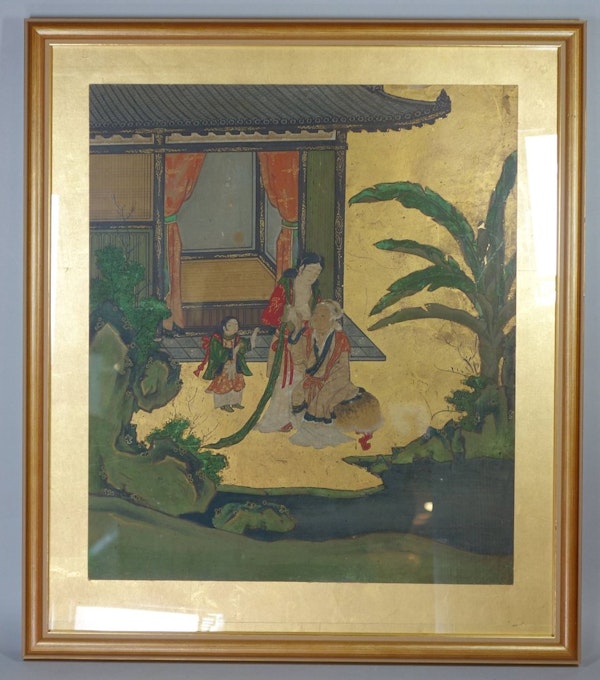Japanese Kano School painting, 17th century
Japanese Kano School painting, 17th century
POA
Description
Japanese Kano School painting, 17th century, in ink and polychrome colours against a gold leaf background, depicting T'ang Fu-jen suckling her mother-in-law in a pavilion garden with a pond amongst plantain and rockwork, with a small child just behind.
Notes: The themes and styles of Chinese art have had a signifiant influence on Japanese painting for hundreds of years, with genres including bird and flower studies, Buddhist religious paintings, inkwash landscapes, and, as seen here, depictions of traditional Confucian tales proving especially popular in medieval and early modern Japan. Despite thematic and stylistic similarities to Chinese models, Japanese paintings display a distinctly Japanese aesthetic. Mirroring this wider narrative of influence and innovation, the Kano school of painters, founded by Kano Masanobu in the 15th century, inItially adhered closely to Chinese models, contributing to a revival of Chinese influence within Japanese medieval culture. However, over time the school developed a bolder, more distinctive style with firm outlines and brighter colours, as seen in this example. The Chinese text Quan xiang ershisi xiao shi xuan 全相二十孝詩選 (Selected verses on all aspects of the twenty-four filial exemplars) was compiled in the fourteenth century by the Yuan dynasty Confucian scholar Guo Jujing. The compilation of tales outlining the central Confucian concept of loyalty towards ones parents proved extremely influential across Asia and was translated into Japanese as Nijushiko 二十四孝 in the fifteenth or sixteenth century as well as becoming a popular theme in Japanese art. The tale depicted in this painting is allegedly based on the true story of the great Grandmother of a Tang dynasty official called Cui Shannan (崔山南). According to Guo Jujing's text, the elderly lady, who had lost all of her teeth in her old age and was thus unable to eat, was suckled by her daughter-in-law, the Lady Tang, who could not bear to see her in-law starve. Apparently a commendable display of respect and self-sacrifice for the benefit of one's elders, the tale is accompanied by the following verse: 'Out of deep respect for the Tswei Family's matron/ After morning toilet/ She would feed the Grand Dame milk/ Kindness such as this is difficult to repay/ May every generation of descendants be so kind'
| item details | |
|---|---|
| Material and Technique | Ink and colour pigment with gold leaf |
| Origin | Japanese |
| Period | 17th Century |
| Dimensions | Dimensions of frame: 40cm. x 46.4cm. (15 3/4in. x 18 1/4in.) |
Product REF: Q707G


